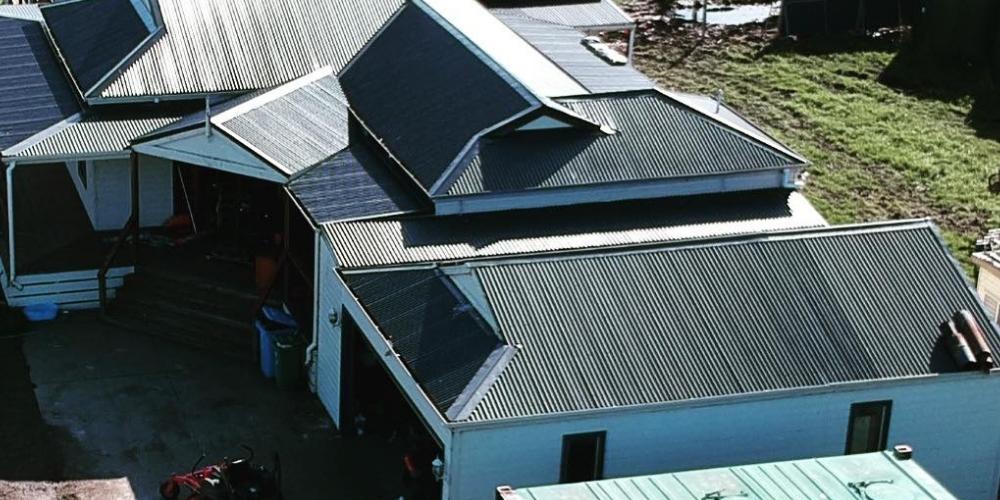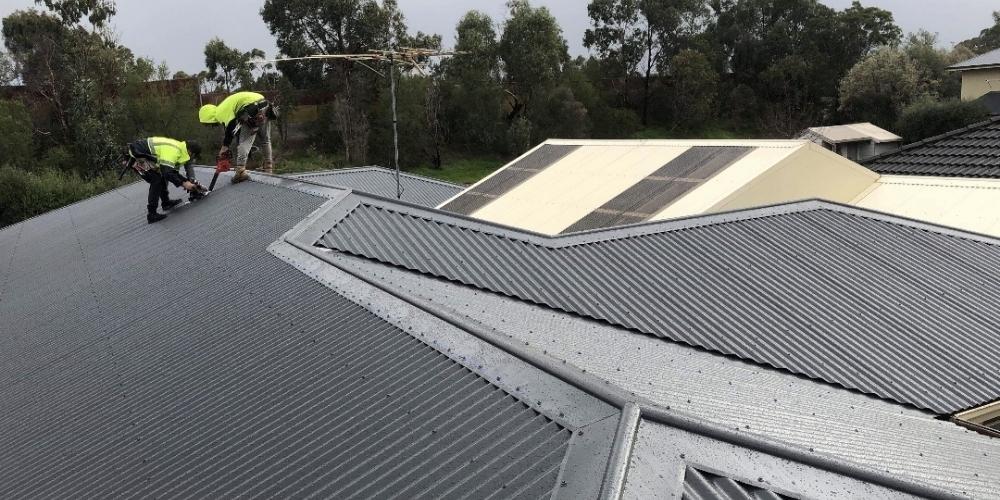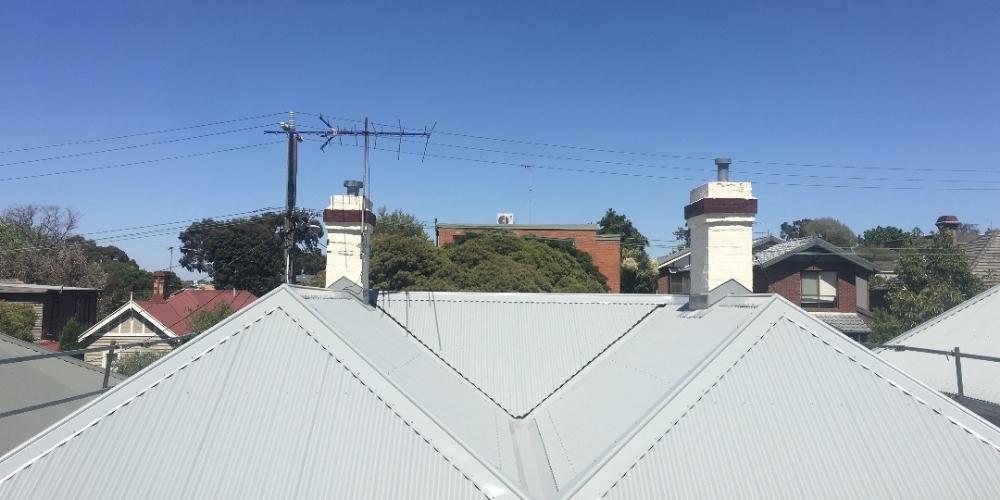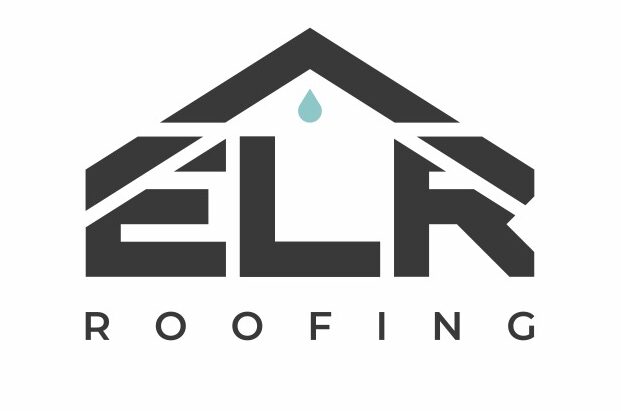Metal roofs, and colorbond in particular, have established themselves as one of the most popular options for homeowners in Australia. Colorbond roof is aesthetically pleasing, lightweight, durable, thermally insulated, and resistant to wear and tear when subjected to the rigours of Australian climate conditions. Colorbond is one of the most widely used roofing materials in Australia.
It is finished with a one-of-a-kind powder coating designed to last indefinitely.
If you consider constructing a new house or improving the one you already have, colorbond roofing is a choice you should explore more. Colorbond roof material comes with a guarantee covering corrosion and weathering caused by the natural environment for thirty years.
Additionally, the roofing colorbond comes with a warranty against the paint peeling and chipping for up to 20 years from the installation date. There is a large selection of designs and colours available for you to choose from for colorbond materials, based on your spending capacity and personal preferences.
This indicates that you may anticipate your roof to endure for 30 years. If there is a problem, you will be able to have defective areas replaced at no additional cost. A roof made with colorbond may survive longer than thirty years. Roofing made of metal typically lasts between 40 to 70 years.

What is Colorbond Roofing?
Roofs made of colorbond, both long-lasting and energy-efficient, are popular for homeowners in Australia. Colorbond was developed in the middle of the nineteenth century to replace corrugated roofs. Even though corrugated roofs were strong, they rusted rapidly and had to be painted often. There is now a superior option: Colorbond steel roofing.
Colorbond has grown in popularity as a roofing material in Australia since its debut in 1966. Pre-painted steel with a zinc core, colorbond is very durable yet lightweight. The manufacturing of this product follows stringent design, production, and testing standards to guarantee that it is constructed to endure. Steel’s colour and corrosion resistance are both enhanced by this protective coating. Colorbond roofing has stood the test of time in Australia and is beautiful, long-lasting, and resilient.
Colorbond steel is a popular choice for roofing because of its extended lifetime. A variety of colours and finishes are available for this product, which is also very efficient in heat transfer, corrosion resistance, and maintenance. Colorbond steel has become a widely used roofing material because of its many advantages.
Colorbond products are all metal roofing materials; however, not all metal roofs are colorbond! It’s critical to recognise the difference.
Benefits of Using Colorbond Roofing
In addition to its longevity, colorbond roofing is a good choice for many reasons. A colorbond metal roof that a professional has fitted comes with a few extra perks.
Colorbond has been a trusted source of roofing material in Australia for more than half a century. It provides long-lasting protection from the weather and helps improve the property value. Colorbond roofing has gained popularity and has become the top roofing choice for most homes in Australia.
The durability of colorbond roofing is seen in the harsh climate of Australia. This product can survive any weather, be it very cold or hot, windy or rainy. Even in places prone to bushfires, colorbond satisfies the requirements for safe usage. Colorbond steel roofing has been subjected to extensive testing for corrosion, durability, and exposure, ensuring robustness and security in any environment.
Colorbond is created and constructed to withstand the effects of any climate, so you can have peace of mind knowing it’s in your home.
Corrosion may occur on other metal roofs due to acid rain and severe rains. Despite this, Colorbond’s five-layer construction ensures that it remains in excellent condition longer. The five-layer protection system of colorbond includes:
- A layer of metallic coating that improves corrosion resistance
- An Australian-manufactured steel standard
- A layer of pre-treatment that aids in the adherence of subsequent layers
- A layer of primer that prevents rusting
- A reflective topcoat for exterior paint.
These layers provide protection against corrosive chemicals that are both comprehensive and long-lasting. They also help your colorbond roof maintain its colour for a more extended period.
Colorbond roofs are available in a wide variety of shades and colour combinations. You may customise your home’s roof using colorbond’s extensive selection of colours and patterns. Colorbond comes in various hues to match any decor, including modern, classic, matte, and ultra shades.
If you’re going for a modern, classic, or historical look, you may use bent or straightened sheets. Colorbond roofs come in various colours and styles to suit any property.
Corrugated, panel, and weatherboard are just a few of the many colorbond styles. Using these choices, you may tailor your roof to your property requirements and preferences.
The energy efficiency of your house will increase thanks to the use of colorbond roofing material. The cost of cooling and heating a home may be directly influenced by the colour of a building’s roof.
During the sweltering summer months, lighter-coloured roofs reflect more heat away from your house than darker-coloured roofs do.
Roofing colorbond sheets use a technique called Thermatech to take advantage of this. As a result of Thermatech technology, your house will be more insulated and less likely to radiate heat from the roof.
The decreased solar absorbance of thermally efficient roof colorbond means less strain on your air conditioner, which means cheaper heating and cooling costs.
Colorbond roofs have the following notable characteristics:
- Thermatech solar reflectance technology is included in 21 of Colorbond’s 22 roofing colours.
- Under the Green Star Communities tool, only five of the 22 Colorbond roof colours are eligible for solar reflective roofing.
Colorbond roofing is an excellent option for any property, regardless of the roof’s pitch. colorbond does not allow water to pool on its surface, unlike other roofing materials, making it perfect for flat roofs. Because of the metal-bonded paint finish, it is water-resistant.
The lighter and more durable colorbond roofing material allows for wider spans and fewer columns needed to support the roof, resulting in a more flexible and open floor plan for homes with open floor plans.
As one of the most reusable and recyclable materials on Earth, colorbond steel is an essential component of colorbond roofing. These roofing materials are easy to transport and produce less trash on-site, decreasing the environmental effect of the construction. Choosing colorbond means helping to build a more environmentally friendly home and world.
Colorbond roofing is a stunning choice for any discriminating buyer or homeowner, thanks to its numerous advantages. Roofs made with colorbond are long-lasting and brilliant in colour. Colorbond roofing improves the visual attractiveness of your house to prospective purchasers.
Because of its longevity and ease of maintenance, colorbond roofing is an excellent investment. Maintaining its appearance is as simple as rinsing it with water regularly. Colorbond roofs may endure at least 30 years if properly maintained.
For the best protection against bush fires, colorbond roofs are the most advanced roofing material. It is possible to utilise colorbond roofing and other materials in the most intense wildfire zones. Even if hit by lightning during a major electrical storm, they will not catch fire since they are noncombustible. Colorbond safeguards your house and everything within it from the worst nature may throw at you.

Colorbond is a product made of steel that is resistant to corrosion. Initially, colorbond roofing was manufactured up of three layers:
- Polyester
- Hot-dip galvanised steel, and
- A covering of polythene that was responsible for imparting the desired colour.
Over the years, both the production method and colorbond roofing price have evolved. Two steel sheets with polythene sandwiched between them provide more thermal efficiency. Colour, strength, water resistance and corrosion resistance are provided by the heated sandwich of two Colorbond roofing layers with two different varnishes. The zinc in the steel protects the roofing materials against corrosion, weather conditions, discolouration, or rotting. The minimal upkeep requirements of Colorbond make it a desirable product.
In addition to the typical grey, brown, and black colours, colorbond also comes in various unique and uncommon colours. This has contributed to the product’s longevity in the market. You could even want to paint your roof a light pink colour.
There is also a vast selection of textured roofing options for colorbond roofs, ranging from smooth to corrugated or ribbed texture roofing options. The circumstances in Australia may also result in less common colours and the more common grey, brown, or even black and copper surface.
How Long Does Colorbond Roofing Last?
When you choose colorbond roofing materials for your house, you not only make a wise investment choice, but you also protect that investment decision. Because colorbond steel comes with various warranties, some of which are good for up to 36 years, it is apparent that colorbond roofs are constructed with longevity in mind. If you decide to go with colorbond for your roofing material, you can rest easy knowing it will last for decades.
Colorbond comes with a guarantee that protects against corrosion and deterioration caused by the sun, rain, and snow for at least 30 years. Additionally, it comes with a warranty against the paint peeling and chipping for 20 years after its installation. However, in reality, a roof made with colorbond may survive far longer than 30 years; in most cases, it can endure 40 to 70 years.
In certain cases, the colour of your colorbond roof may have faded over the years, or you’ve recently moved into a new house and aren’t happy with the existing shade. It’s possible to change the colour of your colorbond roof.
You’ll need to know how to paint a colorbond roof the right way for the best results. As with any major project, you want to make sure the colorbond roof repair is done correctly.
The best way to ensure a long-lasting and effective colorbond roof repaint is to familiarise yourself with the facts regarding repainting colorbond. Let us try to understand the process:
- If your roof shows signs of fading or chalkiness, it may be time to consider a new coat of paint.
- Sometimes your home’s exterior may be marred by a problem known as “stubborn staining.” which can only be removed by covering it up.
- Paint flaking or bubbling may occur over time due to prolonged exposure to the weather. You’ll have to do some preliminary work to ensure the new paint coat has good adhesion.
- Living near the coast puts you at risk for seawater exposure.

How To Repaint A Colorbond Roof?
-
To begin with, the method of repainting is very different from painting a concrete tile roof. This is a multi-layer coating procedure, and preparation is critical for a long-lasting and radiant finish.
The process of repainting a colorbond roof is involved:
Understanding what you’re dealing with is always the first step. It’s possible that what seems to be a deteriorated colorbond roof is contaminants that need to be removed using high-pressure washing. Rust may be lurking behind what appears to be chipping paint. A typical roof will be faded or just worn, which is not uncommon. It is always good to have a colorbond roofing expert check the roof’s condition before repainting your colorbond roof.
Whether your roof needs a paint job or you’re just changing the colour, it’s time to have the job done. After that, the roof is subjected to a 3000psi pressure wash using specialised detergents. Preparation with an industrial pressure cleaning is critical here, as it will break down the old, oxidised paint and leave a surface ready for the new paint to adhere to best. Before priming, if the roof has light or surface rust, a rust shield treatment may be necessary. Poor adhesion and peeling paint might occur from not properly cleaning and preparing the roof.
Several colorbond roof paints don’t need a primer. As a result, to ensure maximum adhesion to previously exposed bare metal on the roof, use a primer that is specifically formulated to do just that. An airless spray gun may be used to apply colorbond primer to the roof. Airless sprayers may apply paint at pressures of up to 3500psi to ensure the paint/primer adheres to the roof.
Roof paint from colorbond is a water-based acrylic membrane designed especially for metal roofs. The paint is applied using an airless spray gun like the priming. Paint adhesion will be compromised using a roller to paint the colorbond roof. Additionally, it will take many hours longer because the previous roll of paint may have dried and degraded adhesion when it overlapped. “Wet on Wet” is a term used to describe the application of colorbond paints; rollers make this almost impossible.
The Final Thought
A roof’s lifespan may be significantly influenced by how it is installed and maintained over its lifetime, which significantly impacts how long it will endure.
However, colorbond roofing is aesthetically pleasing, light and robust, thermally insulated, and resistant to wear and tear and its extended lifespan. Any colorbond roofing material’s lifespan may be extended with the help of a reputable installer and frequent inspections, repairs, and maintenance.
